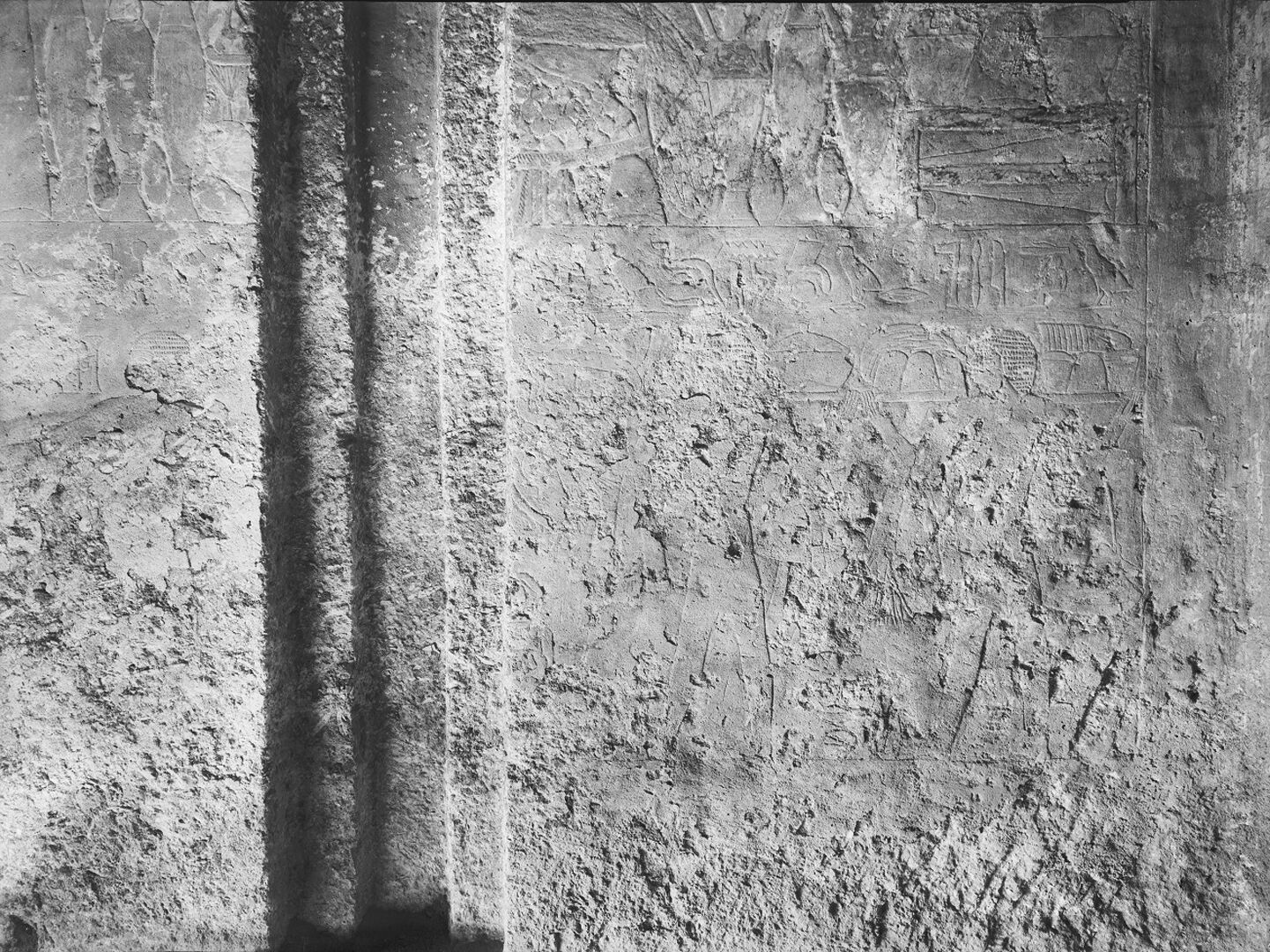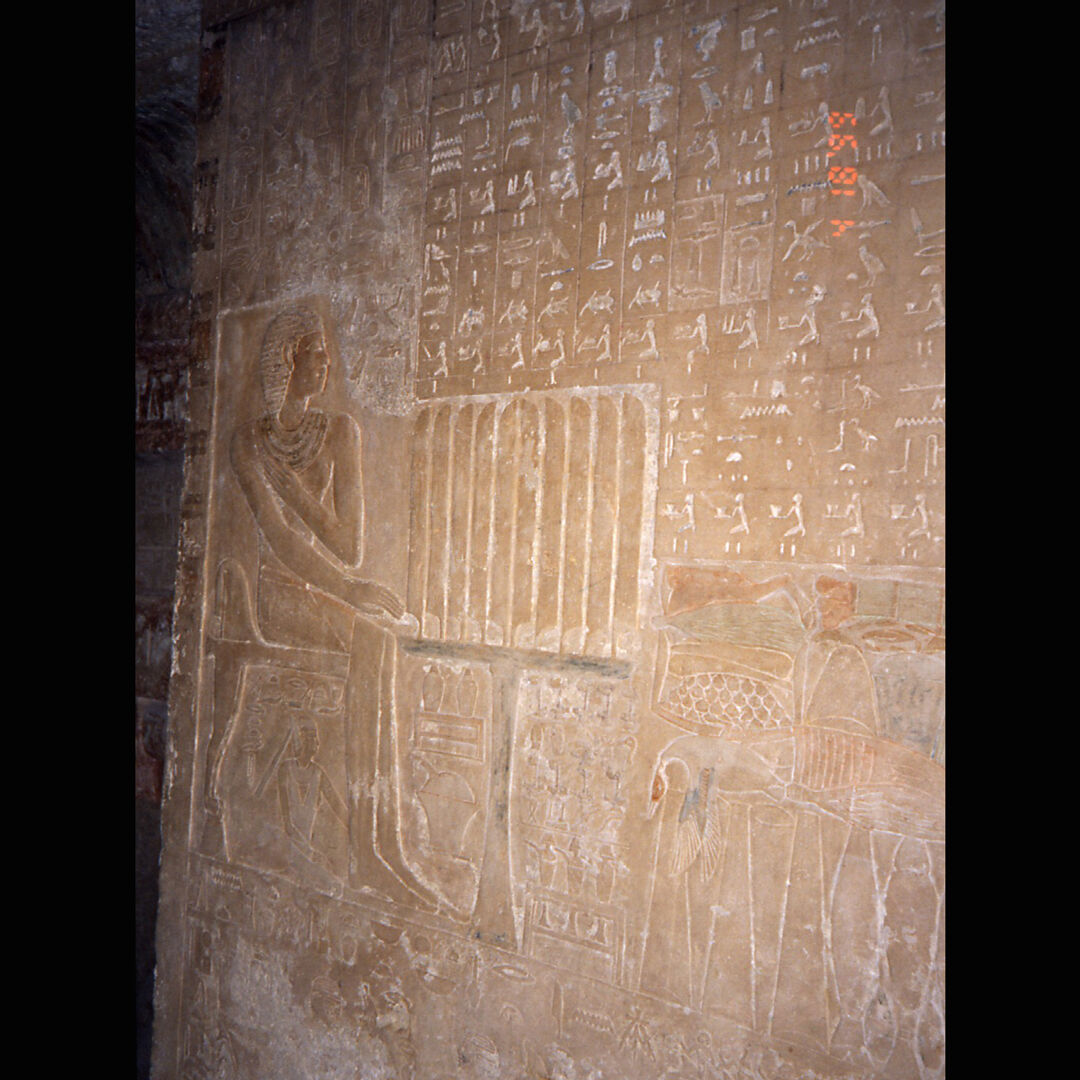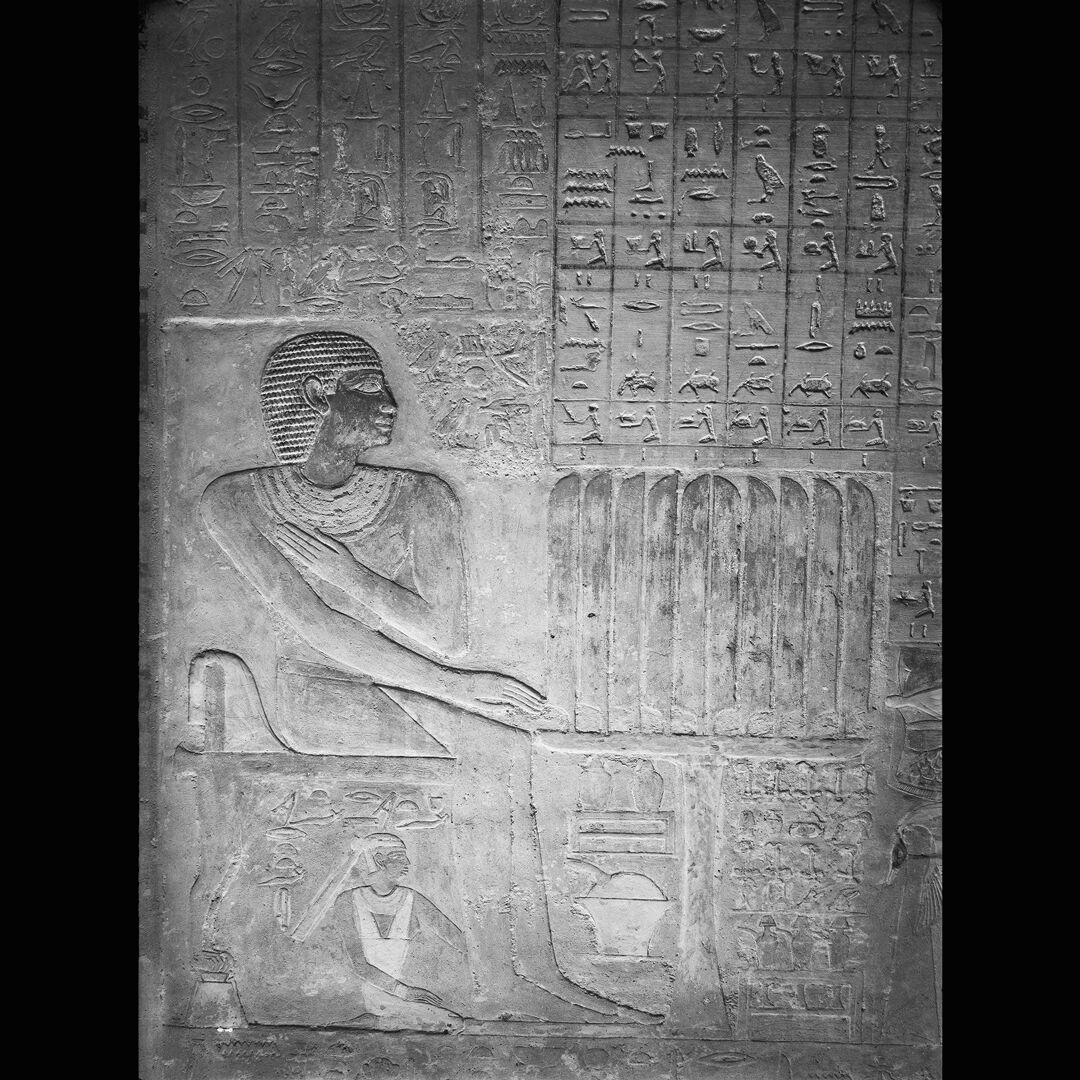The Mastabas of Qar and Idu G 7101 and 7102 - Digitally Revised and Enhanced Edition
Part II - Idu G 7102
Section 3.7 - Offering Chamber - West Wall, North of Niche
West Wall (North of Niche) of the Offering Chamber in relation with area north of G7110-7120; Qar(G7101) and Idu (G7102) (click to enlarge)
Pl. XXXII a. Idu, west wall, right of niche, top left
West Wall, North of Niche. Orthomosaic by Luke Hollis (left), Figure 41. Idu (G7102). West wall, north of stela, with secondary false door (right) (Click to enlarge)
The wall surface is occupied by a seated figure of Idu facing right before an offering table, a text along the top of the wall reading from left to right, a large offering list opposite Idu with 101 compartments and an offering formula in the 102nd, and piles of offerings below the list. In addition there is a register of offering bearers facing left toward Idu below this scene and a horizontal line of text above the bearers. Subsequent to the carving of the wall surface a narrow stela was cut in the northern part of the wall through the pile of offerings, the horizontal line of text, and the procession of bearers.
.jpg)
Reading from left to right: Ḥtp di nswt ḥtp di Inpw tpy ḏw.f ḫnty sḥ-nṯr imy wt nb tꜣ ḏsr pr ḫrw (t ḥnḳt pꜣt) n.f m ꜣbd ... nt m Rkḥ prt Mnw m wpt rnpt m tpy rnpt m ẖrt hrw rꜥ nb n imꜣḫw Idw, “a boon which the king gives, and a boon which Anubis gives, he who is on his hill, foremost of the divine booth, he who is in Wet, lord of the necropolis: that an invocation offering (bread, beer, cakes) come forth for him on the monthly festival and half month festival, on the festival of Rokeh, the procession of Min, at the opening of the year and the first of the year and throughout the course of every day, for the well-provided Idu.”
.jpg)
Text above seated figure in five columns and three horizontal lines facing right: (1) Ḫnty-š Ppy-mn-nfr, (2) sḥḏ wꜥbw Ꜣḫt-Ḫwfw, (3) sḥḏ wꜥbw Wr-Ḫꜥ.f-Rꜥ (4) ẖry tp nswt imy-r wpt ḥtpt-nṯr, (5) imꜣḫw ḫr nṯr ꜥꜣ nb pt, (6) sš ꜥ nswt ḫft ḥr imy-r sšw mrt, (7) imꜣḫw (8) Idw, “(1) tenant-farmer of Pepy-mennefer, (2) inspector of weeb-priests of Akhet-Khufu, (3) inspector of weeb priests of Wer-Khafre, (4) he who is at the head of the king, overseer of the distribution of divine offerings, (5) one well-provided before the great god, lord of the heavens, (6) king’s letter scribe in the presence, overseer of the scribes of the meret-serfs, (7) the well-provided, (8) Idu.”
Text below chair with figure of wife: ḥmt.f mrt.f Mrt-it.s, “His beloved wife, Meretyotes.”
Idu is seated on a chair with lion’s feet terminals (rear legs only shown) and a low back rest. He wears a curled wig reaching to the back of the neck, a broad collar, and short skirt. His right hand is extended to the table of offering breads and his left crossed over his breast. Below the chair sits his wife facing in the same direction and wearing a long white dress with shoulder straps, a broad collar, bracelets and anklets, and a streamer falling from her fillet. Her right hand rests on her lap and her left passes behind Idu’s leg with the fingers shown clasping his right leg. The execution of this section of the wall, particularly in the faces of Idu and his wife, is of the highest quality. Idu’s eye is large and the oval carefully cut. Beneath the table on the left are a stand with vessels and a basin with a ewer on a tray; on the right are nine thousand signs followed by the offerings designated as bread, beer, cakes, cattle, fowl, clothing, linen, ox(?), and gazelle, and below this section an offering stand with three stoppered hes-vessels. In the extensive pile of offerings to the right of the table, one should note the trussed duck with its neck twisted in relief and painted details added to the wings. The twisted duck’s neck in relief also occurs in the scene on the left of the stela niche. It is curious that a narrow stela niche has been added as an afterthought and thereby has destroyed a section of the wall relief. It is lined up with the center of the offering block in front of it. Evidentally two offering slabs were deemed requisite for the cult, one in front of the engaged statue of Idu and a second to its north, perhaps for Idu’s wife’s offerings. Either the slab was placed in position on the north and the narrow false door cut above it, or the false door was cut and the slab centered on it; the latter is more likely, with the spacer block specially cut between the offering slabs.
Northern offering table: l. 1.11 m., w. at side: 0.245 m., w. at center: 0.51 m., thickness: 0.14 m. Spacer block: l. 0.51 m., w. 0.245 m., thickness 0.15 m. Southern offering table (in front of statue): l. 0.96 m., w. at side: 0.25 m., w. at center: 0.51 m., thickness 0.15 m.
.jpg)
Left to right: int nḏt-ḥr rnpt nbt ḫt nb(t) nfrt in msw.f (here an interruptive caption to a figure) [...] rmṯ nw ḏt.f n imꜣḫw ḫr nṯr ꜥꜣ Idw, “bringing gifts of all fresh produce and all good things by his children (caption to figure) [false door lacuna] the men of his estate, to the one well-provided before the great god, Idu.”
.jpg)
Vertical text at left end of register: sḫpt spt ḫpš Ꜣpdw [...], “bringing choice offerings, haunches, fowl, [...].” The first four bearers are evidently sons of Idu, as they are beneath the text so designating them. The first and second bring fowl, while the offerings of the third and fourth are now lacking. The first is designated as: [imy-r] pr, sḥḏ [ḥmw-kꜣ] Idw, “the steward, inspector of [funerary priests] Idu.” There may have been some alteration in the text on the plaster at this point. The second is the imy-r pr Ḳꜣr, “the steward Qar.” The third has only part of the title imy-r pr, “steward,” preserved with the name missing. The fourth has the titles sḥḏ ḥmw-kꜣ sš, “inspector of funerary-priests, scribe,” with the name also missing. At this point the false door cutting has destroyed a portion of the relief and text. A single bearer is missing; presumably he belongs to a group of three, not necessarily sons of Idu, of whom the preserved second and third bear trays of offerings in front of and behind them with vegetables hung over their right elbows and bags on handles over their left elbows. For ḏt.f probably read pr ḏt.f , “his estate”, in the horizontal band of text. Of the captions near the men’s feet, the second (first preserved) of the group has the title ḥm-kꜣ, “funerary priest,” and the remains of a name, while the last has only traces of a few hieroglyphs of the name.
Photos from the Archive



.jpg)

.jpg)





.jpg)
.jpg)
.jpg)
.jpg)







0 comment(s)
Leave a comment(We'll keep your email address private)